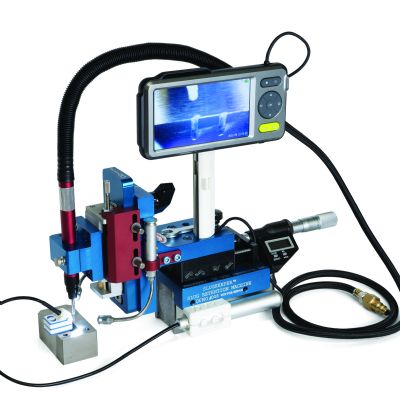Straighteners and Feeders
Straighteners that inadequately straighten the incoming material may require frequent adjustments and complex tool compensation.
Stampers select from three basic types of coil-correction equipment: flatteners, precision straighteners and levelers. A five-roll flattener may not adequately remove coil crossbow, but a 13-roll precision straightener will. When crossbow causes quality problems in a particular stamping, constant die adjustments (from coil to coil and within a coil) will be required to maintain part quality if the incoming material is simply flattened. On the other hand, a precision straightener can work the incoming material hard enough so that it becomes flat, with minimum or no crossbow, and present the incoming material to the die consistently in this condition.
Stampers also can purchase stock feeders that practically eliminate the need for pilots in a die. And, some feeders will force pilots to work beyond their original intent. Not presenting the work accurately to the next event surely will result in inconsistencies of product as well as other problems, such as breakage and premature tool wear.
Press
Stamping-press motion is simple and basic. The ram (or slide) reciprocates down and up, causing the stamping tool to process the work material. What we often take for granted is that press repeatability in three-dimensional space (left-right, fore-aft, up-down) produces part consistency. Worn or sloppy gibbing, crankshaft bearings or pitman connections will produce inconsistency of the press and, consequently, of the parts being produced.
Don’t overlook how changes in process temperature can affect linear expansion of press members and die components. A press structure will change size as it warms to its normal operating temperature. And, in-die process heat (due to friction) can change the characteristics of punches and die sections by altering their original design size or clearances. When the press structure and die components change shape, the parts that they produce surely will be affected.
Lubrication
Press lubrication not only ensures press longevity but also contributes to process consistency. Process lubricants play a major role in the consistent quality of the parts being produced. In-process lubrication provides consistent friction and cooling conditions, important to ensure consistent part production and to prolong tooling life.
Lubricant type and viscosity, the amount applied and its location, and its operating temperature range all are critical factors. Most lubricants are specifically formulated to work within specific process-temperature ranges.
Design
Product and tooling design represent major contributors to stamped-part inconsistencies. Product designers often lack a thorough knowledge of what’s involved in producing the parts that they need and, consequently, introduce problems and inconsistency in the manufacture of those parts.
Tooling designs that cut corners to reduce tooling costs inevitably will produce inconsistency. It may not happen at die buy-off, but such designs eventually will be exposed. Examples include use of thin and weak sections that lack the rigidity needed to withstand long production runs; improper tooling materials that wear prematurely; improper cutting clearances; and inadequate or ineffective piloting that results in inconsistent part location. “Forming in air” is the term used to describe forming operations where the part is not rigidly held by a spring-loaded pressure pad prior to forming; this practice almost always causes inconsistency.
Progressive-die processes can be challenging, especially when trying to solve quality-related problems. Did the material feed properly? Are the pilots positioning the strip accurately? Is pitch length growing, so that the distance between the pilot holes exceeds design limits, or is it shrinking so that the distance between pilots is less than designed? Is a stretch flange splitting due to a mismatched cut, or are extrusions splitting due to a burr? Is the die hitting too hard or not hard enough? Are deep-drawn features splitting, due to restricted material flow or to an incorrectly specified radius? Is the carrier design appropriate? Is the die hitting level in all the stations? Is die timing correct with the die fully loaded? Do cutting clearances change with the die fully loaded due to tipping moments?
Achieving consistent part quality relates directly to how well pressroom personnel understand all of the stamping-process inputs. Our challenge: Identify those variables that contribute most to part-to-part variation, and control those variables to the best of our ability. MF Technologies: Coil and Sheet Handling, Lubrication, Tooling
 Peter Ulintz
Peter Ulintz







